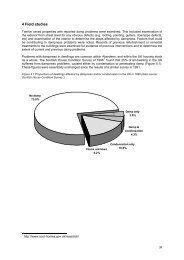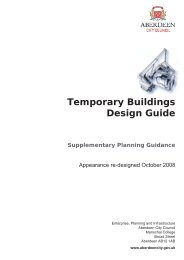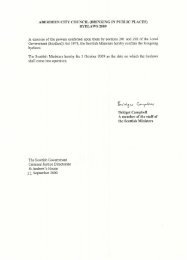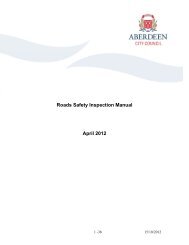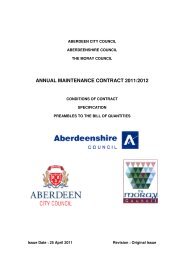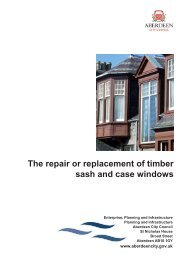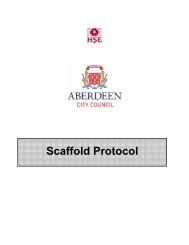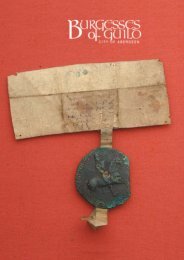Tullos Hill - A Guide - Aberdeen City Council
Tullos Hill - A Guide - Aberdeen City Council
Tullos Hill - A Guide - Aberdeen City Council
- No tags were found...
Create successful ePaper yourself
Turn your PDF publications into a flip-book with our unique Google optimized e-Paper software.
Above: Excavation of gun emplacement site Below: Aerial photograph of gun emplacements from south, 1946Bronze Age cemeteryas the more wellknowncairnsmentioned above,while others relate toclearance of groundfor cultivation inprehistoric or laterperiods.Two short seasons ofexcavation directedby CFA Archaeology,in 2010 and 2012,and involving largenumbers of localvolunteers, focusedon two of therecently discoveredfeatures, both ofwhich were found to be of prehistoric,probably Bronze Age date. One was a hutcircle, the foundation of a substantial stoneand wooden building or roundhouse inwhich the first residents of <strong>Tullos</strong> <strong>Hill</strong> wouldhave lived while farming the surroundingland. The other was afurther burial cairn,which may havecontained crematedbone from a funeralpyre at that spot.At present there islittle evidence ofhuman activity inthe area underdiscussion betweenlater prehistory andthe 12th century AD.There is oneexception in theform of part of asolid silver chain,often described as‘Pictish’ and datingfrom about the 7th century, which wasfound in the 18th century by a farmer inthe nearby Bay of Nigg. Containing 95%silver this was obviously a high statusobject and hints at a continuity of humanactivity in the wider area.HistoryThe historical evidence for <strong>Tullos</strong> <strong>Hill</strong>begins in the later 12th century. In theclosing years of that century the church inthe Bay of Nigg (the now ruined St Fittick’s)and the lands from the mouth of the RiverDee down to Cove, so including <strong>Tullos</strong> <strong>Hill</strong>,were given by King William the Lion to theAbbot of the Abbey of Arbroath. The Abbotremained the feudal superior of theselands until the Reformation in 1560.From the 12th century onwards we cantrace the development of life in this area.The main settlements developed closer tothe mouth of the Dee in the form of thevillages of Upper and Lower Torry. <strong>Tullos</strong><strong>Hill</strong> does not seem to have been settledduring the Medieval period. Althoughsome limited farming was undertaken onparts of the <strong>Hill</strong>, much of the land was notamenable to agricultural development. Adocument dated 1281 mentions theextensive moor, marsh and rocky barrensoils of the lands.Following the Reformation of 1560, controlof <strong>Tullos</strong> <strong>Hill</strong> passed out of the hands of thechurch. Eventually, following a number ofchanges, all of the lands from the mouth ofthe Dee down to Cove became splitbetween the town of <strong>Aberdeen</strong> and theMenzies family, the Lairds of Pitfodels. Anumber of disputes arose between thesetwo parties due to the archaic system ofland holding that was in operation at thetime: run rig. This meant that each of thetwo main land owners did not hold theirlands in anything like one or two large andfairly self contained parcels of land, butrather one owned one field and the otherthe next, resulting in a large amount oflitigation between the two parties.Bay of Nigg from <strong>Tullos</strong> <strong>Hill</strong> with St Fittick’s Church right of centre45



